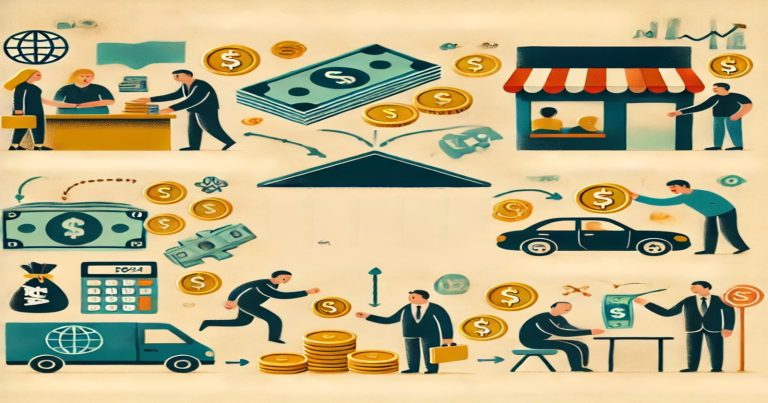Money in various forms is integral to the day and serves several essential functions in an economy. These functions help to understand the whole system better. Money has primary and secondary functions, and they say that the building blocks make money significant in facilitating economic transactions, enhancing efficiency, and assuring stability in economic systems. The functions of money deal with the roles that money plays in connection with trade, related phenomena, and actions. It is a medium of exchange, a store of value, a unit of account, and a standard deferred payment in its simplest definition. These are the basic initial functions of money, without which smooth economic functioning may not occur. However, there are secondary functions of money as well, which are much more indirect in observing money for supporting the economy. This article will explain the functions of money in detail. Not only that, it will also provide information regarding the primary and secondary functions of money, their importance, and the contribution they give to the economic system.
Primary Functions of Money
The functions of money are indispensable to the economy. These main functions make money a positive tool for trade and investment as well as for savings. Knowing what these main functions allow, one gains insight into how money operates in an economy.
Medium of Exchange
The primary function of money is really as a medium for trade. It is what enables the goods and services to be exchanged without the requirement of bartering. The bartering system, for example, required individuals to trade goods for other goods and did not afford much else. Under this system, some of the major limitations were that a “double coincident demand” had to be there; both parties had to want what the other had to offer. How simple it becomes for an individual to convert his goods or services to cash to use it in buying other goods or services he actually needs. This activity makes barter obsolete and the whole transaction so easy and fast.
For instance, if you want to buy food in a grocery store, you do not have to look for an individual who is willing to exchange their loaf of bread for an apple. You can just go ahead, get your food, and pay for it with money. That grocery store now has money and can use it to buy more goods or services.
The Store of Value
Another prominent attribute of money is its ability to act as a store of value. This means money enables an individual to save and keep wealth for future use. In the modern world, money functions as a standard of value in terms of whether or not it is to be consumed.
An example would be if a person were to earn money from either labour or an investment. In this case, the person would choose to store the money until it is needed for consumption rather than spend it immediately. Money allows the holder to store wealth to be used in planning for future expenditures: whether to buy a house, pay for education, or for retirement matters.
Another reason for preferring to hold money in bank accounts, savings accounts, and even in physical cash is the store-of-value function. What constitutes a store of value, however, is subject to the stability of the money. As time goes on, inflation and depreciation in currency will eat into the actual value of money.
Unit of Account
The unit of account acts as a measure of measurement by which goods and services can be valued and compared to one another using a standard currency; it is that function that makes possible the comparison of values of those many different items.
For example, when you go to the store and see a shirt for 500 rupees, you immediately understand what it is worth compared to other goods such as bread, which could go for 50 rupees. The unit of account function is essential to ensuring money also assists one in price comparison, which is a further simplification of economic decision-making.
Standard of Deferred Payment
This function allows money to serve as a means of payment in the future. In this capacity, money assists transactions involving credit or loans. When a person secures a loan or agrees to make a payment for something in the future, money serves as the measure of valuation for the debt.
For example, when you buy the car with a loan, the future payment agreed upon (let’s say that is 500,000 rupees) will be the standard for the debt. This function has relevance to the credit system, wherein people can borrow against the money and lend it.
Secondary Functions of Money
It has secondary functions in addition to the primary functions, which help the economy grow, stabilize, and develop. These functions are not easily traceable, but they are equally important among the most important things supporting the larger economic system.
Growth of Economies
Money serves its secondary function in the facilitation of economic growth. In being a store of value and a medium of exchange, money provides an opportunity for people to save and invest. Savings and investments form the basis of economic development in promoting business, generating employment, and increasing production.
Greater investment in new projects by businesses and individuals is also the result of this reliance on money by businesses and individuals for their transactional needs, leading ultimately to an increase in the levels of production in economies and an overall increase in economic growth. It is exactly for this reason that stable and well-functioning money systems are vital for the growth of economies over the long term.
Diminishes the Development of Labor Specialization
Money allows a person or organization to specialize in a specific task, which leads to better productivity. Without money, everyone needed to be self-sufficient or barter. Money enables an individual or organization to concentrate fully on producing whatever it is best at while further obtaining other goods or services with money.
Thus, one person may focus on farming, while the other makes manufactured products. Both accomplish their goal and earn money because money is used as a medium.
Provides Liquidity
Another function of money is to create liquidity, which is defined as being capable of converting promptly into cash without much loss of value. This primary function is, thus, very critical for both organizations and individuals trying to meet their short-term financial requirements. For example, instances may arise when a person or company urgently needs cash for either a purchase or emergency expenditure. The different forms of money can be used to immediately provide cash, such as withdrawals from a bank and credit cards. Money’s function of liquidity helps business operations to go on smoothly and enables individuals to address urgent financial needs.
Acts as a Measure of Economic Stability
It is always measured by the economic stability of an economy. In an economy, central banks and governments measure the health of the economy by money supply metrics and inflation rate. These economic indicators help policymakers make informed decisions with respect to monetary policy, intervening through changes in interest rates, or fighting inflation.
Therefore, money, which acts as a standard to defer payment and a unit of account, measures economic stability. When the money supply is regulated while inflation remains the same, the economy would function smoothly, and all businesses and consumers can expect predictable outcomes.
Differences Between Primary and Secondary Functions of Money
Two functions of money: primary and secondary. Both form an integral part of the economy, catering to its different aspects. Their effects on everyday transactions are direct in the case of primary functions; secondary functions, on the other hand, ensure long-term growth and stability in the economy.
| Type of Function | Primary Function | Secondary Function |
| Medium of Exchange | Goes with transactions and trade. | It enables the growth of business activity through that. |
| Store of Value | It allows savings and accumulation of wealth. | Saves and invests for economic stability |
| Unit of Account | Measuring for pricing goods and services | Measurement is in terms of the performance and stability of the economy |
| Standard of Deferred Payment | Provision of payments, loans, and debts in the future | Supports the system of credits and thus financial liquidity |
Functions of Money FAQs
1. What are the 4 primary functions of money?
Money serves as a medium for exchange, a unit of account, a store of value, and a standard of deferred payment.
2. What are the 10 functions of money, class 12?
The 10 functions are:- medium of exchange, measure of value, store of value, standard of deferred payments, transfer of value, liquidity, distribution of national income, basis of credit, increase in productivity, and economic development.
3. What are the 4 functions of money?
The four functions are medium of exchange, unit of account, store of value, and method of deferred payment.
4. What are the 5 major functions of the money market?
The functions of the money market include providing short-term funds, liquidity to banks, monetary policy support, investment avenues, and price stability maintenance.
5. What are the three functions of money?
Money is one of the media of exchange, a store of value, and a unit of account.


